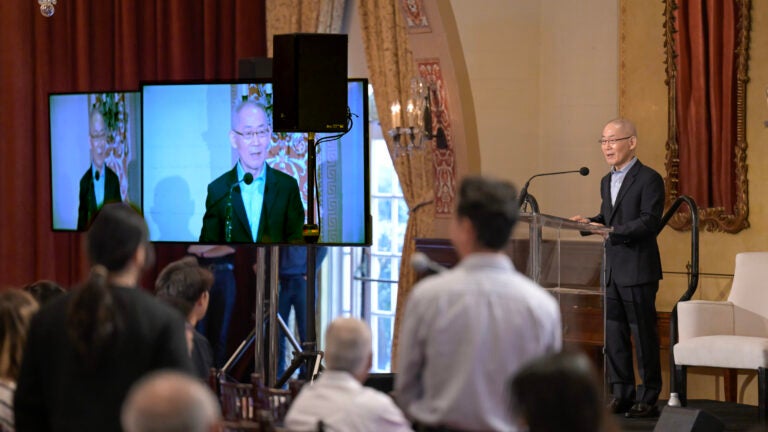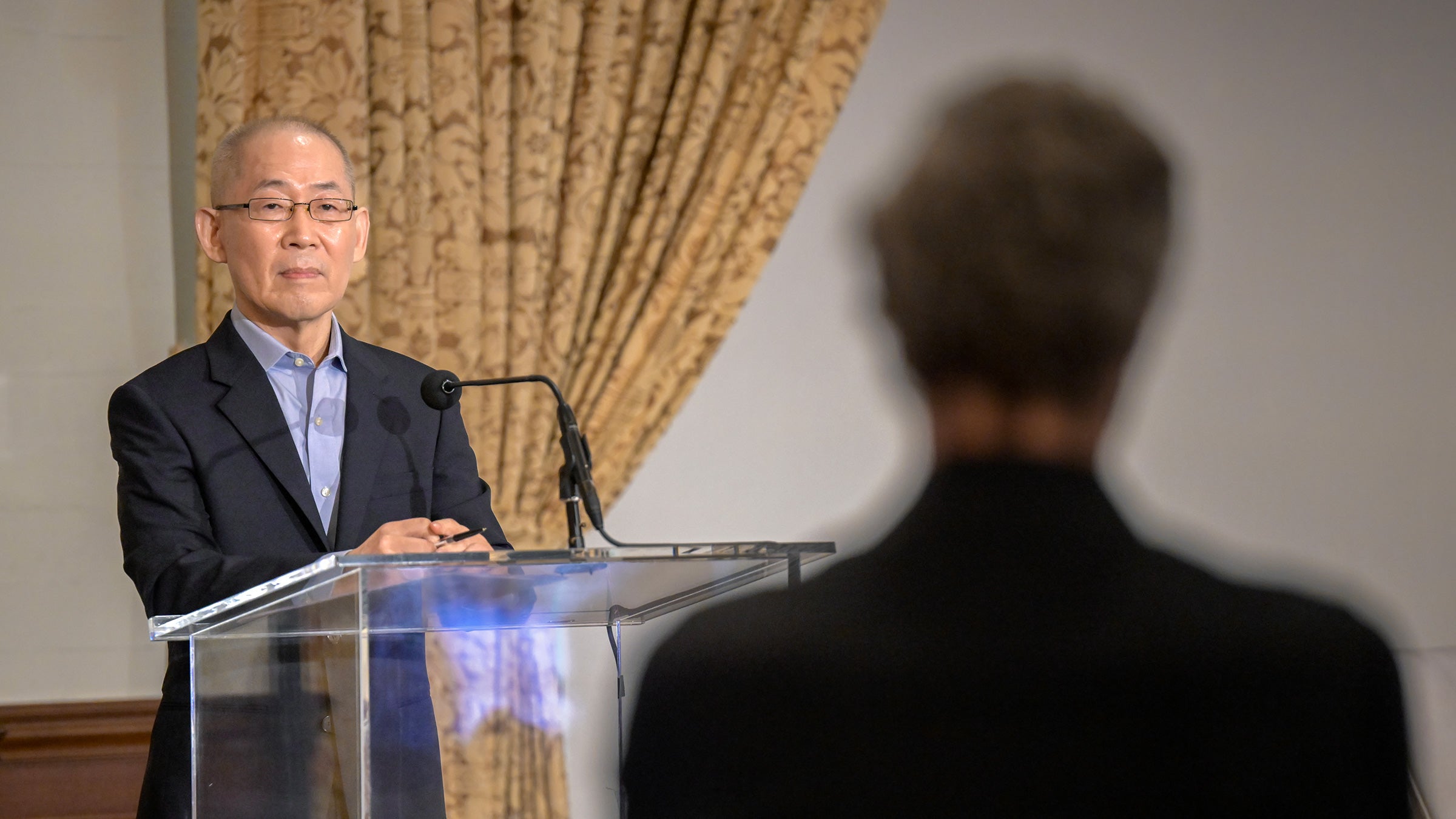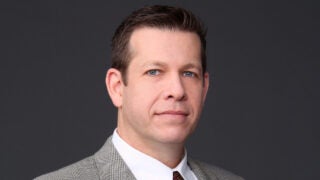
“Solutions not only offer the tangible ways to address the challenge, but they also provide hope,” Hoesung Lee said in his keynote address. (USC Photo/Gus Ruelas)
USC hosts leaders in climate research at Solutions for a Sustainable Future conference
The conference brought together leading experts to address three aspects of climate change: energy and technology, food and water, and human behavior.

“We have ample proof that climate change is a grave threat to our well-being and the well-being of our entire planet, but we have an even greater need to offer solutions,” said Lee, an expert on the economics of climate change and former chair of the Intergovernmental Panel on Climate Change — the world’s most authoritative source for evidence-based information about climate change and responses to it.
“Solutions not only offer the tangible ways to address the challenge, but they also provide hope,” he added. “Hope drives our motivation to confront climate change, and it is the wellspring of innovation and cooperation.”
Lee was one of nearly a dozen experts who spoke at the Solutions for a Sustainable Future conference at USC’s University Park Campus.
The all-day conference was organized through a collaboration of the USC Price School of Public Policy, the USC Viterbi School of Engineering and the USC Center for Sustainability Solutions. The Center for the Political Future at the USC Dornsife College of Letters, Arts and Sciences and its Wrigley Institute for Environment and Sustainability also helped promote the event.
Lee gave the keynote address Tuesday morning, encouraging the room to resist argument and conflict. He instead promoted a message of unity in how we discuss climate change.

“Climate action requires the best of each one of us, and we need empathy to recognize that we live in a diverse world in which everyone has different responsibilities and different abilities to enact change,” Lee said. “Some can do a lot while others will need help managing change, and that change will be shaped by the choices we make starting now.”
Solutions for a Sustainable Future: The state of food and water
One of the first panel discussions of the day explored different approaches to developing more sustainable supplies of fresh water and food. Moderated by Robin Craig, the Robert C. Packard Trustee Chair in Law at the USC Gould School of Law, the discussion featured four panelists with expertise in the fields of academia, policy, business and government.
Pat Brown, former Stanford University professor and founder of Impossible Foods, talked about water usage by the beef and dairy industry in California and its impact on the state both financially and environmentally. According to Brown, the beef and dairy industry uses up nearly half of California’s water and only accounts for about 0.3% of the state’s total GDP.
“That industry is our biggest opportunity to put the brakes and actually to turn back the clock on climate change,” Brown said, arguing that phasing out the beef and dairy industry should be “right at the top of the list” of climate change solutions.
Fellow panelist Michael Obersteiner, director of the Environmental Change Institute at the University of Oxford, was quick to point out how phasing out an entire industry from one state would only be a start to solving the crisis globally.
“You would need to have Californians eat Impossible products,” Obersteiner said, which prompted laughter from the audience. “Because otherwise, stop production here, it’ll be sourced from somewhere else.”
Claudia Faunt, another expert on the panel, serves as the program chief for the Groundwater Availability and Use Section at the United States Geological Survey’s California Water Science Center in San Diego. Faunt added that high water consumption is not solely an issue in the beef industry: high-water crops such as almonds and alfalfa are also top exports in the state.
“We ship it to Saudi Arabia, who is not allowed to use water out of their own groundwater basins, so these solutions are global in nature,” she said. “This is not going to help us with the climate problem in the long run.”
Preserving the Paris Agreement
The conference also featured a discussion with Sue Biniaz, deputy special envoy for climate for the Office of the U.S. Special Presidential Envoy for Climate. As one of the architects of the Paris Agreement, Biniaz is one of the nation’s point people in negotiating global climate agreements.
Mahta Moghaddam, vice dean for research at USC Viterbi and co-chair of USC’s Presidential Working Group on Sustainability, interviewed Biniaz. When asked about diplomatic tools for negotiating around climate change, Biniaz said one of the biggest components is getting governments to agree on what the actual goals are and the actions needed to implement them.
“We created this concept of nationally determined contributions, and those would be the emissions commitments of each country under the Paris Agreement,” Biniaz said. “We had to use diplomacy to get countries to put in ambitious commitments and then figure out how they were going to implement them.”
Biniaz went on to talk about the early difficulties of approaching a global solution for a problem that nations have differing opinions on.
“You have some candidates who are existentially threatened by climate change itself, especially a low-lying small island where your land might actually disappear as a result of sea levels rising, but the oil-exporting countries would say they’re existentially threatened by the responses to climate change by moving away from fossil fuels,” Biniaz said.
“How is it possible to come up with some kind of agreement that addresses the concerns of both of those types of countries? I often marvel that we reach agreement at all.”
Another major issue Biniaz addressed is the idea that some countries commit more than others, which can lead to an almost apathetic response.
“Sometimes it’s just a defense against doing anything in United States: ‘If others are not going to do anything then why should we?’” she said. “It’s just an argument to not take action.”
Solutions for a Sustainable Future: A thorough discussion and the road ahead
On a day when experts discussed realistic and timely options to reduce emissions from energy production and transportation, and overcoming human resistance to climate action, one idea persisted. It’s an idea that Lee presented to the room during the first speech of the day: “The answer is entirely up to us.”
“The good news is that the world has technology, knowledge and capital to avoid the worst impacts of climate change … the more ambitious we are, the wider the benefits for nature and people,” Lee said.
“Let’s hope we make the right choices, because the ones we make now and in the next few years will reverberate around the world for hundreds and even thousands of years.”



